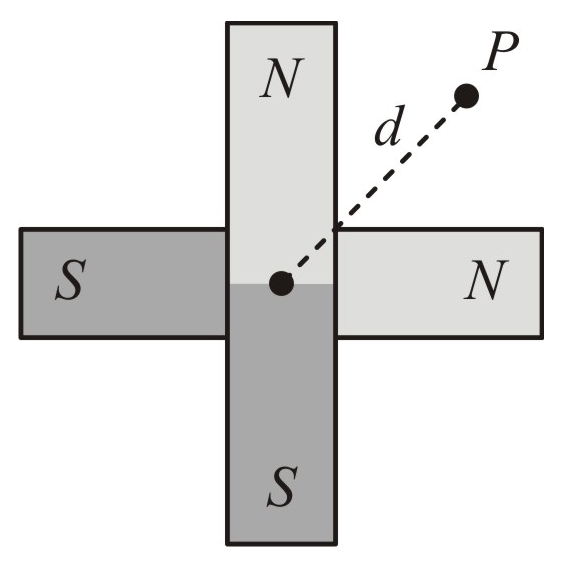Two short magnets of equal dipole moments \(M\) are fastened perpendicularly at their centres (figure). The magnitude of the magnetic field at a distance \(d\) from the centre on the bisector of the right angle is:

1.
\(\frac{\mu_{0}}{4 \pi}\frac{M}{d^{3}}\)
2.
\(\frac{\mu_{0}}{4 \pi}\frac{M \sqrt{2}}{d^{3}}\)
3.
\(\frac{\mu_{0}}{4 \pi}\frac{2 \sqrt{2} M}{d^{3}}\)
4.
\(\frac{\mu_{0}}{4 \pi}\frac{2 M}{d^{3}}\)
The variation of magnetic susceptibility with temperature for a diamagnetic substance is best represented by:
| 1. |  |
2. |  |
| 3. |  |
4. |  |
The variation of magnetic susceptibility with absolute temperature T for a ferromagnetic material is
The relative permeability of a ferromagnetic substance varies with temperature (T) according to the curve
(1) A
(2) B
(3) C
(4) D
The variation of the intensity of magnetisation \((I)\) with respect to the magnetising field \((H)\) in a diamagnetic substance is described by the graph:

| 1. | \(OD\) | 2. | \(OC\) |
| 3. | \(OB\) | 4. | \(OA\) |
If be the apparent angles of dip observed in two vertical planes at right angles to each other, then the true angle of dip is given by
(a)
(b)
(c)
(d)
The magnetic susceptibility is negative for
1. paramagnetic material only
2. ferromagnetic material only
3. paramagnetic and ferromagnetic materials
4. diamagnetic material only
The following figures show the arrangement of bar magnet in different configurations. Each magnet has magnetic dipole moment m. Which configuration has the highest net magnetic dipole moment?
(i)


1. (i)
2. (ii)
3. (iii)
4. (iv)
A magnetic needle suspended parallel to a
magnetic field requires J of work to turn
it through . The torque needed to maintain
the needle in this position will be
(1) J
(2) 3 J
(3) J
(4) J
There are four light-weight-rod samples; A, B, C, D separately suspended by threads. A bar magnet is slowly brought near each sample and the following observations are noted:
| i. | A is feebly repelled |
| ii. | B is feebly attracted |
| iii. | C is strongly attracted |
| iv. | D remains unaffected |
Which one of the following is true?
| 1. | C is of a diamagnetic material |
| 2. | D is of a ferromagnetic material |
| 3. | A is of a non-magnetic material |
| 4. | B is of a paramagnetic material |









